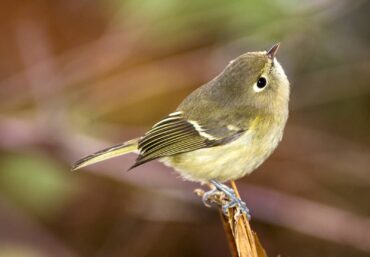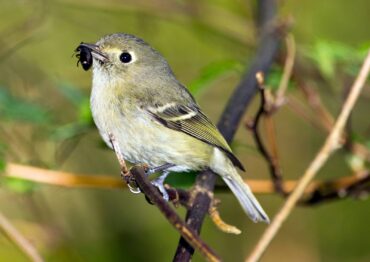
Songbirds come in many varieties. Some, like bushtits, are tiny, while others, like meadowlarks, are large. Some have distinctive sounds, like the onomatopoeia call of the black-capped chickadee. And others have unmistakable plumage, like the male western tanager.
But not all songbirds make such a lasting impression. Numerous subtle species are often overlooked by everyone except high-level birders. The most commonly identified songbirds either frequently visit backyard feeders or are very colorful.
In West Sound’s realm of small, drab, olive green birds that rarely, if ever, visit feeders, ruby-crowned kinglets are present from fall to spring and various flycatchers breed here in summer. And yet, somehow, another similar-looking species that is present year-round is often missed. The Hutton’s vireo goes about its business unaware that it’s perhaps the most unknown, yet fairly common, songbird in the area.
Limited to the Western Hemisphere, the world’s 52 vireo species reside in the forests of North, Central and South America. Fifteen species live in North America.
Four species breed in Washington: the red-eyed vireo, mainly in the northern counties; the Cassin’s vireo, which prefers Eastern Washington’s dry forests and occasionally shows itself in Western Washington; the warbling vireo, which can be found any place that has trees; and the Hutton’s vireo, which is limited to the Puget Sound and coastal forests.
All of North America’s vireo species are migratory. Many of them winter in Central America, except for the Hutton’s vireo, which is a year-round species across its range, making it unique among vireos.

The Hutton’s vireo’s full range extends from the coastal and inland forests of southern British Columbia, Canada, to northern Baja California, Mexico. It also breeds across the Mexican highlands, slipping into the mountainous regions of the American Southwest. The Hutton’s vireo prefers evergreen forests with a moderately dense understory.
The name vireo is Latin for “I am green,” as nearly all vireo species have some olive green plumage. The Hutton’s vireo is named for naturalist William Hutton, who collected a sample of the species in Monterey, California, in 1847.
In winter, individual birds often join mixed flocks of songbirds, which usually include chickadees, nuthatches, warblers, golden-crowned kinglets and the almost identical ruby-crowned kinglets, with whom they are often confused. Thus, Hutton’s vireos are often overlooked, though they may be foraging in plain sight.
Both Hutton’s vireos and ruby-crowned kinglets are olive green and very small. Ruby-crowned kinglets are slightly more diminutive, measuring about 4 inches in length, while the Hutton’s vireo is at least a half inch longer. Male kinglets display a red crown in the breeding season, which is generally seen as a red stripe on the top of the head in winter.
Hutton’s vireos have a stockier build than kinglets and a thicker bill as compared to a kinglet’s thin bill. The easiest way to visually tell the two species apart is to look at the feet. Both species have black legs, but kinglets have orange feet, while the Hutton’s vireo’s feet are black.
Observers with advanced birding skills can identify the Hutton’s vireo by sound and foraging behavior. Male Hutton’s vireos sing incessantly in late winter and early spring to lay claim to breeding territory. While it has a repertoire of various sounds, the most common call is “zu-wee, zu-wee, zu-wee,” which it repeats for several minutes at a time.
Hutton’s vireos also have a more relaxed approached to foraging for insects, spiders and berries, which they glean from trees and shrubs. In contrast, the hyperactive ruby-crowned kinglet is constantly in a frenzy as it flutters from branch to branch.
Both parents share the responsibilities of raising a family. A round nest of lichen, grass and spiderwebs is placed in a fork of a bush or tree, well hidden by the surrounding foliage. The pair trades off incubating the four eggs for about two weeks. For another fortnight, the parents stay busy taking food to the nestlings and carrying fecal sacs away to keep the nest clean.
To throw off potential predators, parents take an indirect flight when bringing food to the nest by making two or three stops in other trees along the way. Families stay together for about three weeks after the young have left the nest. Parents continue to feed the fledglings until they can fend for themselves.
Numbers are currently stable, but since they rely on insects and larvae for food, Hutton’s vireos are always susceptible to habitat degradation due to overuse of pesticides. This can lead to population declines in affected areas.
Flycatchers are heading south and kinglets are returning to West Sound. Olive green songbirds are not all the same. So grab your binoculars and a field guide and look for a Hutton’s vireo. There may be one hiding in plain sight.





























